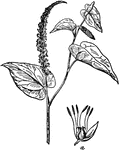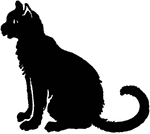
Field Sparrow
The Field Sparrow, Spizella pusilla, is a small sparrow. Adults have brown upperparts, a light brown…
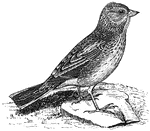
Vesper Sparrow
The Vesper Sparrow, Pooecetes gramineus, is a medium-sized sparrow. It is the only member of the genus…
![The Whip-poor-will or whippoorwill, Caprimulgus vociferus, is a medium-sized (22-27 cm) nightjar from North and Central America. The Whip-poor-will is commonly heard within its range, but less often seen. It is named onomatopoeically after its call. This bird is sometimes confused[1] with the related Chuck-will's-widow (Caprimulgus carolinensis) which has a similar but lower-pitched and slower call. Adults have mottled plumage: the upperparts are grey, black and brown; the lower parts are grey and black. They have a very short bill and a black throat. Males have a white patch below the throat and white tips on the outer tail feathers; in the female, these parts are light brown.](https://etc.usf.edu/clipart/57000/57013/57013_whippoorwill_mth.gif)
Whip-poor-will
The Whip-poor-will or whippoorwill, Caprimulgus vociferus, is a medium-sized (22-27 cm) nightjar from…

Purple Martin (Male)
The Purple Martin (Progne subis) is the largest North American swallow at 20 cm length. Adults have…
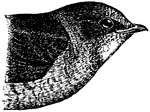
Purple Martin (Female)
The Purple Martin (Progne subis) is the largest North American swallow at 20 cm length. Adults have…

Section of Vertebrate
Diagrammatic sections of the ideal vertebrate. A, sagittal section showing the brain and spinal cord…
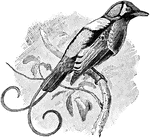
Wilson's Bird of Paradise
Cicinnurus respublica: a species of Bird of Paradise in the subgenus Diphyllodes.

Scissortailed Flycatcher
The Scissortailed Flycatcher (Milvulus forficatus) is a tyrant flycatcher in the Tyrannidae family.

Fox
A fox is an animal belonging to any one of about 27 species (of which only 12 actually belong to the…
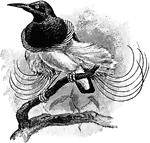
Twelve-Wired Bird of Paradise
The Twelve-Wired Bird of Paradise (Seleucidis melanoleucus) is a black and yellow bird of paradise named…

Penaud's Artificial Flying Bird
An illustration of Penaud's artificial flying bird. "a b c d, a', b' c' d', lactic wings which twist…

Pea Crab
The pea crab is a small crab in the family Pinnotheridae that lives symbiotically in oysters, clams,…
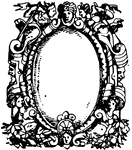
Printer's-Mark Typographical Frame
This Printer's-mark typographical frame was designed during the Italian Renaissance, 16th century. The…
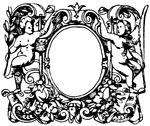
Printer's-Mark Typographical Frame
This Printer's-mark typographical frame was designed during the Italian Renaissance, 16th century. The…
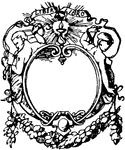
Printer's-Mark Typographical Frame
This Printer's-mark typographical frame was designed in Paris during the 19th century. The head and…

Great Sickle-Bill Bird of Paradise
The Great Sickle-Bill (Epimachus speciosus) is a bird of paradise in the Paradisaeidae family.
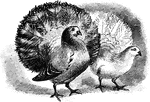
Two Fantail Pigeons
The Fantail is a popular breed of Fancy Pigeon which are domesticated varieties of the Rock Pigeon (Columba…

Types of Files
"Files. a, cotter-file when large, and verge- or pivot-file when small; b, square file (parallel or…

Skeleton of Perch
"Skeleton of Fish (Perch). a, intermaxillaries; b, nasal region; c, dentary bone of mandible; d, orbit…

Shortnose Sturgeon Tail
"Heterocercal Caudal Fin of a Sturgeon (Acipenser brevirostris), showing the series of fulcrums, Fl,…

Ostrich
"Struthio camelus, the Ostrich or "Camel-bird" of North Africa now extends from Barbary to Arabia, and…

Kiwi
Kiwi, Apteryx australis, of the South Island, is lighter (than the Apteryx mantelli of North Island),…

Storm Petrel Swimming with Reflection
The storm Petrel "of the Mediterranean and North Atlantic from Greenland to South Africa, which breeds…
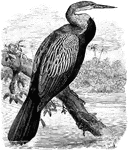
Indian Darter
"The Indian Darter (Plotus melangaster) or snake-bird of tropical and subtropical America, ranging northwards…
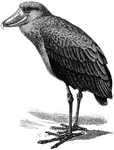
Shoebill
"Balaeniceps rex, the Shoebill, of the White Nile, has a short crest, and is brownish-grey with blackish…

Hammerhead Standing Near Water
"Scopus umbretta, the Hammerhead, of Madagascar and a large part of the Ethiopian Range, is purplish-brown,…
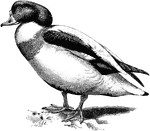
Shelduck
Tadorna cornuta, the Sheld-Drake or Bargander, ...shews a white collar on the lower neck followed by…

Secretary Bird
"Standing some four feet high on very long legs, this bird (Secretary Bird) gives the impression of…
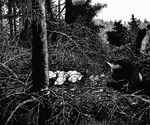
Two Sparrow Hawk in a Large Flat Nest of Twigs with Five Young Sparrow-Hawk Beside a Tree Trunk
"Accipiter nisus, the Sparrow-Hawk, which breeds throughout Europe, North Africa, Asia north of the…
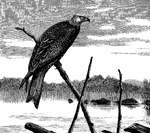
Red Kite Resting on a Branch by a Body of Water
"Milvus milvus, the Red Kite or Forked Tail Glead of the Old World, ranging from the Atlantic Islands-except,…

Hoatzin
"The Hoatzin (Opisthocomus cristatus) is curious and highly specialized. "The body is long and thin,…

Kagu
"Rhinochetus jubatus, the Kuga ... has powder-down patches that are profusely distributed over the whole…

Sun-Bittern
"Eurypyga helias, Sun-Bittern, has a black head, with a white stripe above and under each eye, and a…

Curlew
"Numenius arquata, the Curlew or Whaup, breeds freely on the moorlands of Britain; and extends throughout…

Indian Jacana
"Hydrophasianus chirurgus, the Indian Jacana, of most of the Indian Region, is Bronzy-brown above and…
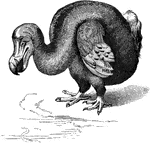
Dodo
"The Dodo, ...was an immense Pigeon-like bird bigger than a Turkey, with an aborted keel to the sternum…
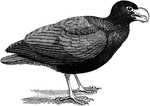
Tooth-Billed Pigeon
Didunculus strigirostris, the Manu-mea or Red Bird of the islands of Upolu, Salvai, and Tutuila in Samoan…
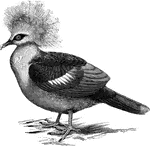
Crowned Pigeon
"Goura coronata, the Crowned Pigeon, discovered by Dampier in 1699, is bluish-slate -coloured, with…
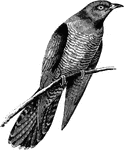
Cuckoo
"Cuculus canorus the familiar Cuckoo of Britain and nearly all the Old World, is greyish-brown above…
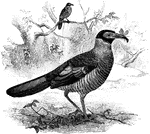
Two Radiated Ground Cuckoo, One with an Insect in its Mouth, the Other in a Tree Branch in a wooded Area
"The plumage is brownish, with white margins to the feathers and a purple tinge on the rufous-mottled…
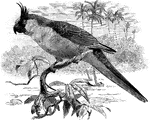
Uvaean Parakeet
The Nymphicus uvaeesis, Uvaean Parakeet, has a dark coloured face, black beak, green plumage and crest,…
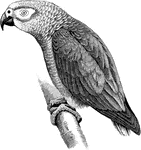
Grey Parrot
"Psittacus erithacus, the Grey Parrot, which ranges across Equatorial Africa, is ashy-grey, with black…

A Kea Sitting a Tree Branch
"Nestor notabilis, the Kea of the south island of New Zealand, has olive-green plumage with blackish…

Kirombo
"Leptosoma discolor, the Kiromobo or Vorondreo of Madagascar, and the Comoro Islands, which has a big…
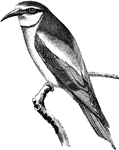
Bee Eater
"Merops Apiaster, the Bee-eater, has ruddy-brown head, neck, upper back, and broad alar bar, buff lower…

Hoopoe
"Upupa epops, not unfrequently visits Britain, where it has nested on several occasions; it breeds from…

Common Swift Flying Through the Air by a Structure and a Tree with its Mouth Open
"The coloration of the twenty or more species of Cypselus is sooty-black or mouse-brown, frequently…

Long Tailed Hummingbird
"Aithurus polytmus, the Long-tailed Hummingbird, peculiar to Jamaica, the two tail-feathers next to…
Quezal
"Pharomacrus mocinno, the Quezal of the higher districts of Guatemala to Veragua, is brilliant iridescent…
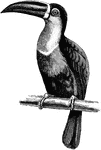
Ariel Toucan
The Rhamphastus ariel, or Ariel Toucan, is black with a yellow or orange rump and throat. The brilliant…

A Broadbill Sitting on a Tree Branch
"The plumage in the Calyptomena viridis of the Indo-Malay countries is bright green, with large black…

Indian Pitta
"Pitta brachyura, the Indian Pitta, has plumage that exhibits vivid scarlet, blue, and green tints,…
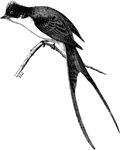
Scissor-tail
"Milvulus tyrannus, Scissor-tail, normally exhibits olive, grey, yellow, or white in varying proportions."…

Lyre-bird
"Menura superba, the Lyre-bird, of New South Wales and South Queensland, some thirty-three inches long,…
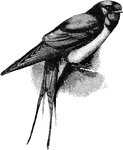
Swallow
"Hirundo rustica, the Swallow, is metallic black, with a variable amount of chestnut or rufous on the…
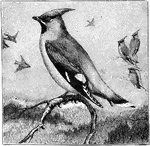
One Waxwing Sitting on a Branch in the Forefront with Three Waxwings Sitting on Branches and Four Flying Around in the Background
"Both sexes of our irregular winter-visitor the Waxwing (Ampelis garrulus) are silky greyish-brown,…
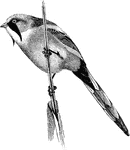
Reed Pheasant
"Panurus biarmicus, the "Bearded Tit" or "Reed-Pheasant" plumage is orange-brown above, with grey crown…
